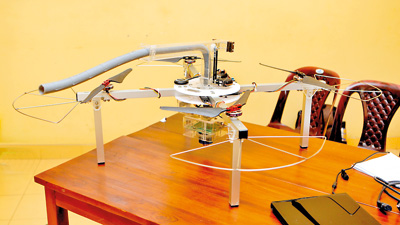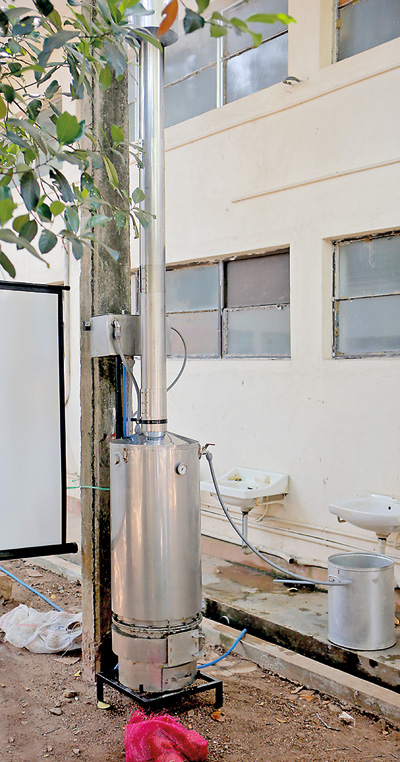Battling cobwebs, efficiency in boilers and chimney designs at MechX
The eight-legged weavers flaunt their rich array of (eyesore) architectures usually in high up and hard to reach places, stopping anyone from actually removing them.

Cobweb machine.
While cleaners – both domestic and industrial – are repulsed by the “guy lines” surrounded webs on high up surfaces, more often than not they lose the battle against spiders.
Now there’s hope. The Department of Mechanical Engineering, University of Moratuwa Batch 15 for their Final Year Projects made a machine focusing on developing cleaning cobwebs at higher places in domestic or industrial buildings.
“To increase the efficiency and effectiveness, robots are used in the present days in the cleaning processes,” Hashan Hettiarachchi, group member of this project told the Business Times at the Department of Mechanical Engineering, University of Moratuwa, and annual exhibition of Final Year Projects – MechX on Monday, adding that the sticks or brooms used to clean cobwebs isn’t a good method to remove them because it can make the surrounding environment untidy. “In industrial processes, cleanliness is one of the most considerable factors. Also the stick-based cobweb removing equipment is unable to reach higher roofs as it is difficult to control when the stick become longer. So the targeted objective was the ability to reach the higher roofs and forbidden places are the main advantage of this machine,” he explained noting that the flexible sucking part is included with this machine.
Cobwebs
Cobwebs are removed by a sucking method by using an electronic ducted fan (EDF) unit, filter and a flexible hose. The flexible hose is used to reach cobwebs and it is controlled by the robot manipulator. EDF unit is used to suck cobwebs into the chamber which contains a filter by avoiding, falling of the cobwebs and making the surrounding environment untidy. In the 3- member group, Kasun Nadeera and Chathura Jayashan were the others in the team.

Small scale bio mass heater. Pix by Sameera Weerasekera.
Another interesting project was the boiler manufacturer made by M.L.A.H Eranda, H.W.S.S De Silva, and A.P.L Udayanga. Use of small scale boilers has become very popular in Sri Lanka in the recent past, to fulfill the hot water requirement in domestic, hospital, and small industrial applications. The Sri Lanka Sustainable Energy Authority (SLSEA) has taken a forward step to empower local manufacturers to manufacture hot water boilers locally with the cooperation of the UNDP. Design improvement of the small-scale biomass boiler manufactured by Spectra Industries (Pvt) Ltd, has been identified under the said vision of inspiring local bio-mass boiler manufactures.
“Before starting the project, the efficiency of this 12 kilo watt bio-mass hot water boiler, was estimated at 53 per cent. It was found that the safety and maintain the boiler were at a moderate level compared to other industrial hot water boilers available in the market. The product was manufactured as a single unit and during maintenance, it was very hard to accommodate with the previous model,” Mr. Eranda explained to the Business Times.
Boiler efficiency
During this project work, the efficiency of the boiler was increased to 68 per cent by improving the internal water tube arrangement of the boiler and by introducing a pre-heater near the combustion chamber region.
He said that since the initial boiler design was patented by the owner of the company, the basic geometry of the boiler was changed without violating its patented features while improving its performance. “Pipe sizing and flange modification have been done without increasing the complexity of the boiler geometry to accommodate for better maintenance. The final improved version is able to separate into four sub-assemblies making maintenance and repairing much easier. And also a maintenance and operation manual was created for this specific boiler design. And lastly the material of the boiler was shifted from 304 litre stainless steel to 316 litre stainless steel considering the hygiene conditions at elevated temperatures,” Mr. De Silva noted.
Mr. Udayanga added that with all the efficiency, maintainability and safety improvements, now the modified boiler is capable of providing 50 litres of water at 980C within 10 minutes, consuming 3kg of biomass fuel (tested for coconut shells) at it’s working temperature.
Design guidelines for smokestacks of standalone emergency generators to satisfy Sri Lankan Emission Standards was made by R.P.J.M. Randunu, W.H.N.C. Jayasinghe, and P.M. Ranatunga.
Smokestacks offer a means of local control of pollutants discharged into the atmosphere from combustion plants, incineration plant and industrial process. They are used to control the deposition of pollutants to the ground or their ambient concentrations over long- or short-time scales.
“If the smokestack height is not properly sized there can be ground level air pollution causing health hazards and nausea (due to odour for example) for humans, increase in operation and maintenance costs due to increase of backpressure in the generator and legal implications by not fulfilling government regulations,” Mr. Ranatunga explained.
There may also be the necessity for additional abatement controls on the discharges from a particular source to minimise the discharge where practically possible. “However, even when there are high levels of abatement, there is likely to be a residual discharge that must be effectively dispersed by means of an adequate stack height,” Mr. Randunu said noting that the research study was conducted to develop a method to design smokestacks of standalone emergency generators to match the government regulations while maintaining the generator efficiency. Project outcome provides a simple guideline for generator owners to design the smokestack of the standalone emergency generators, Mr. Jayasinghe said adding that this provides an effective method to estimate the discharge pollutant concentrations in the ground level from standalone sources. Currently, this guideline is developed for 10kW to 1MW generators which are located in the Colombo district. This can be extended to other generator capacities and different areas of Sri Lanka.


